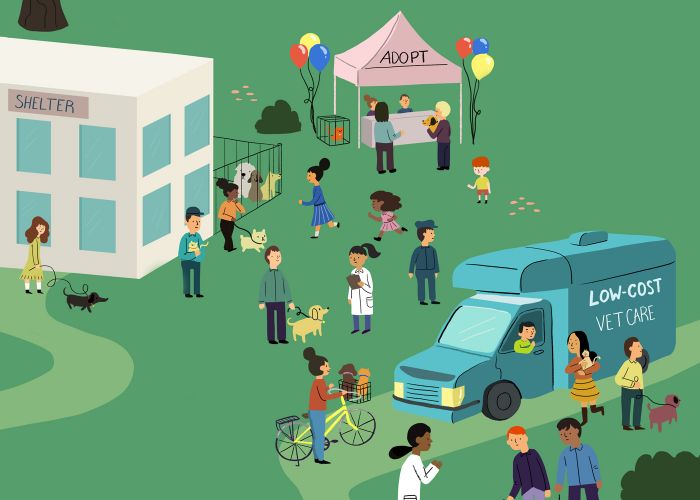The high cost of caring
How can we combat drug and alcohol abuse in the animal welfare field?

Sally Smith (whose name has been changed to protect her anonymity) was executive director of a private animal shelter for three years, in charge of 30 staff members, when she was fired for alcohol abuse.
Smith had been struggling with chronic pain from a health condition that was exacerbated by her stressful work environment. Alcohol had become a coping strategy, not only to deal with her physical pain, but to try to offset the rigors of shelter work.
As a 20-year veteran of the animal welfare field, Smith says that drinking has been “part of the culture” almost everywhere she’s worked. For her, being at the highest level of management contributed to her feelings of isolation; when she had the opportunity to network with peers, it was usually over drinks.
One day, several staffers approached her and said they were concerned. Smith brushed them off. She now recognizes her reaction as part of another mode of thinking common to the field: a hero complex. When her co-workers approached her, she thought, “I don’t have a problem. I fix problems.” That identity made it harder for her to accept that she needed help.
Eventually, the shelter’s attorney took her out for lunch and told her she needed to get help, but offered no solutions. “I didn’t know how or where to get help,” she says, so she kept drinking.
The situation came to a head on one particularly stressful day, when Smith drank before work. One of her staffers called a board member, and she was sent for a drug test. She had to drive herself to the facility, nearly 30 minutes away. The test showed Smith was intoxicated. The board voted to fire her, announcing that she was leaving for medical reasons and offering her a severance.
Smith’s case may be a more extreme example, but alcohol and drug abuse are not uncommon in the animal welfare field, where people face all the stressors of a typical work environment, with looming issues of life and death rolled into the mix. Skilled at caring for animals, many organizations don’t prioritize people care until low staff morale, on-the-job errors or talent drain from staff turnover make the problem too glaring to ignore.
Numbing the pain
“A lot of people in this profession have experienced some kind of trauma … and if it’s unresolved, it can be really problematic,” says Hilary Hager, senior director of volunteer engagement for The HSUS. From working in shelters with low save rates to witnessing terrible animal cruelty, Hager says, many in the field are carrying a silent burden. “They’re just getting triggered all the time.”
The numbers that are typically used to measure an organization’s success often won’t reveal much about the health of its staff and volunteers. By the typical metrics—such as its 98-percent save rate—things were going well at Austin Animal Center in Texas, where Kristen Auerbach worked as deputy director. But when the shelter rolled out a new support group for people who’d lost pets, says Auerbach, “We were shocked when, the first night, the room was packed with our own staff.”
To Auerbach, it was a flashing neon sign, signaling that it wasn’t the animals in the shelter’s care, but the employees, who were struggling.
Auerbach, currently director of the Pima Animal Care Center in Tucson, Arizona, started her career in animal welfare in 1999, at a time when the sheltering world was dealing with euthanasia numbers far worse than today’s. Today, intake and euthanasia numbers are still overwhelming in some parts of the country—and even in places where they’re not, the work remains emotionally stressful.
As manager of a Tennessee shelter decades ago, Jim Tedford, president and CEO of the Society of Animal Welfare Administrators, says he walked into that job thinking, “I’m going to fix all this.” But he quickly realized progress would be incremental. At the time, the shelter was taking in as many as 200 animals a day, and Tedford says some days it felt like the facility was a “euthanasia machine.”
Even at the high-resource shelters where Tedford has worked—such as the Humane Society at Lollypop Farm in Rochester, New York—“we still had staff who were completely stressed out all the time.” You still witness cruelty cases, says Tedford, “and you still tend to take sort of a beating from the community” via attacks through social media.
Veterinarian Jennifer Steketee, executive director of the Santa Fe Animal Shelter and Humane Society in New Mexico, agrees. Her organization takes in more than 5,000 animals per year and has a 94-percent live-release rate, but many employees still find it difficult to manage the emotions that come with sheltering work.
Some of the biggest challenges have more to do with people than animals. In Santa Fe, shelter staff who have out-facing jobs—such as those at the shelter’s intake station, who assist city and county animal control with cruelty cases—tend to have higher turnover than other positions, Steketee thinks in part due to human-related stress.
“So many people get into this work because of their love for animals, but it can be the work with people that’s the most challenging,” says Hager. Many animal control officers (ACOs) have told Hager they feel an increase in aggressive behavior toward them. “There’s a heightened sensitivity to people in uniform,” says Hager, and that’s not only dangerous for ACOs, but also depressing. “Being called ‘killers’ leaves them feeling misunderstood and isolated,” she says.
Hager has conducted compassion fatigue trainings all around the U.S. and abroad, and at a recent session in San Francisco, shelter staff described feeling like “accidental social workers” as they struggled to help pet owners deal with difficult life circumstances brought on largely by economic challenges. Says Hager, “There’s a human tragedy behind every door that opens.”

When ‘happy hour’ isn’t
It’s possible to cope with these stressors and develop greater resilience, but “learning how to manage our anxiety and self-soothe is not something we generally learn growing up,” says Hager. Some people develop unhealthy ways to cope and soothe their own pain.
The most common addiction problem Hager sees in the animal welfare field is drinking. Auerbach agrees, calling alcohol abuse “an unspoken problem in many municipalities.”
That may be because alcohol is not only more socially acceptable than other substances, it’s also “a bonding thing,” says Hager. Going out for happy hour can be a way to blow off steam.
But tossing a few back while griping about policies or “irresponsible” pet owners can actually make things worse. “When people vent, they tend to do it together,” says Hager. “They’re trying to manage their anxiety. They may end up spreading it, instead.”
Auerbach notes that helping employees cope with all this stress in healthy ways is challenging in an environment where you can’t eliminate the underlying problem—the sometimes painful nature of the work itself. Both she and Hager describe a vicious cycle of substance abuse—compassion fatigue fuels a need to drink, and alcohol abuse can increase compassion fatigue.
Given that it can be impossible to unlink substance abuse from compassion fatigue, it’s important to learn to identify signs of both.
Compassion fatigue is more than just feeling worn out. Hager describes it as “the decline of a person’s ability to feel and care for others that comes with being in mission-driven work” and says its appearance can take many forms. It’s not just the down-and-depressed employee in tears who could be struggling; behaviors such as anger and aggression can be indicators, as well.
Auerbach says some common signs of substance abuse include workers falling asleep on the job, smelling like alcohol at work, not showing up for shifts or calling in sick after weekends. General irritability, moodiness or other personality changes, along with an otherwise unexplained decline in work performance, can also be signs that an employee needs help.
When it comes to employees who may be in trouble, Smith recommends approaching them gently and offering suggestions for solutions. After she was fired, it took her another four years to get help. While she doesn’t hold a grudge against her former employer, she can’t help but feel if the organization had offered some practical solutions and support, she might have gotten sober sooner.
Substance abuse is often treated as a character defect, and that sense of being judged may lead to increased denials from someone who’s struggling. “It’s important to get past that if you can,” Smith says, and it helps to try to diminish any shame the employee may be feeling. Expressing an understanding of the challenges they’re facing may help.
Some employees refuse suggestions of a rehab program because they don’t have care options for their own pets. In situations like these, a shelter may be able to offer help with boarding. There are also treatment models—such as outpatient programs—that allow employees to work during the day and attend meetings before or after the workday.
One challenge of referring employees for help is that therapists and counselors outside the world of animal welfare often have no idea what challenges employees face. To lay the groundwork, Auerbach reaches out to counselors at her employee assistance plan (EAP) and to other local therapists to explain what life in sheltering is like, “so staff don’t feel like they have to take these people to school” when they’ve reached out for help.
Smith says if an employee remains in denial, it’s important to underscore with them how their substance abuse is affecting their work and to clearly lay out the consequences if things don’t change, then follow through on those discussions. Depending on the rules where the shelter operates and whether it’s municipal or private, drug testing may or may not be an option.
In the end, says Smith, someone’s only going to get help if they’re ready, but how you approach them could make a world of difference.
Stressing self-care
Beyond intervening effectively and compassionately in moments of crisis, employers can also work to build a healthier and more supportive work environment. Giving employees more time off and encouraging them to use it is a start, but management’s efforts can’t stop there. Both managers and employees alike should be taught to look for signs of substance abuse and compassion fatigue (see “Resources” below).
“We need to have conversations about self-care and help staff make the connections,” says Auerbach. Many of her employees lead such busy lives that substance use, especially alcohol abuse, “can sneak up on them.”
“I really think we have to start talking about how we deal with life and death every day,” she adds, suggesting that the industry look to first responders, physicians, nurses and social workers to find models for dealing with job stress. To help, her shelter in Pima is starting an employee support group to cope with loss, which will be facilitated on a volunteer basis by mental health professionals from the community. The group has a dual purpose—to provide emotional support for employees, and to give them an opportunity to get together that doesn’t involve drinking—something Auerbach and Hager agree that the industry needs to do a better job of offering regularly.
Management needs to look at self-care not as an afterthought, but as an essential job skill, Auerbach says. “We talk ad nauseam about where to store the cat carriers, but we barely talk about things like self-care.” Teaching self-care, she points out, is one way current managers can help build the next generation of animal welfare leaders. “We need to start talking to employees about self-care on day one, so they can last in this field.”
One way managers can teach self-care is to model it in their own practices. Auerbach’s regular self-care plan involves yoga and therapy, along with a daily five-mile walk. But she realizes many of her employees don’t have the same amount of time or resources, so she’s also trying to build self-care activities into daily life at the shelter. Simple activities such as having lunch together outdoors and having employees take the time to identify and write down their self-care needs are healthy workday activities, and such activities make for bonding time that’s an alternative to traditional happy hours.
“Sometimes we use all our compassion on the animals, and we don’t have any left over for people,” says Hager. Creating an atmosphere where self-care is emphasized will help give staff the emotional skills and the emotional support to stay healthy and stick around.







